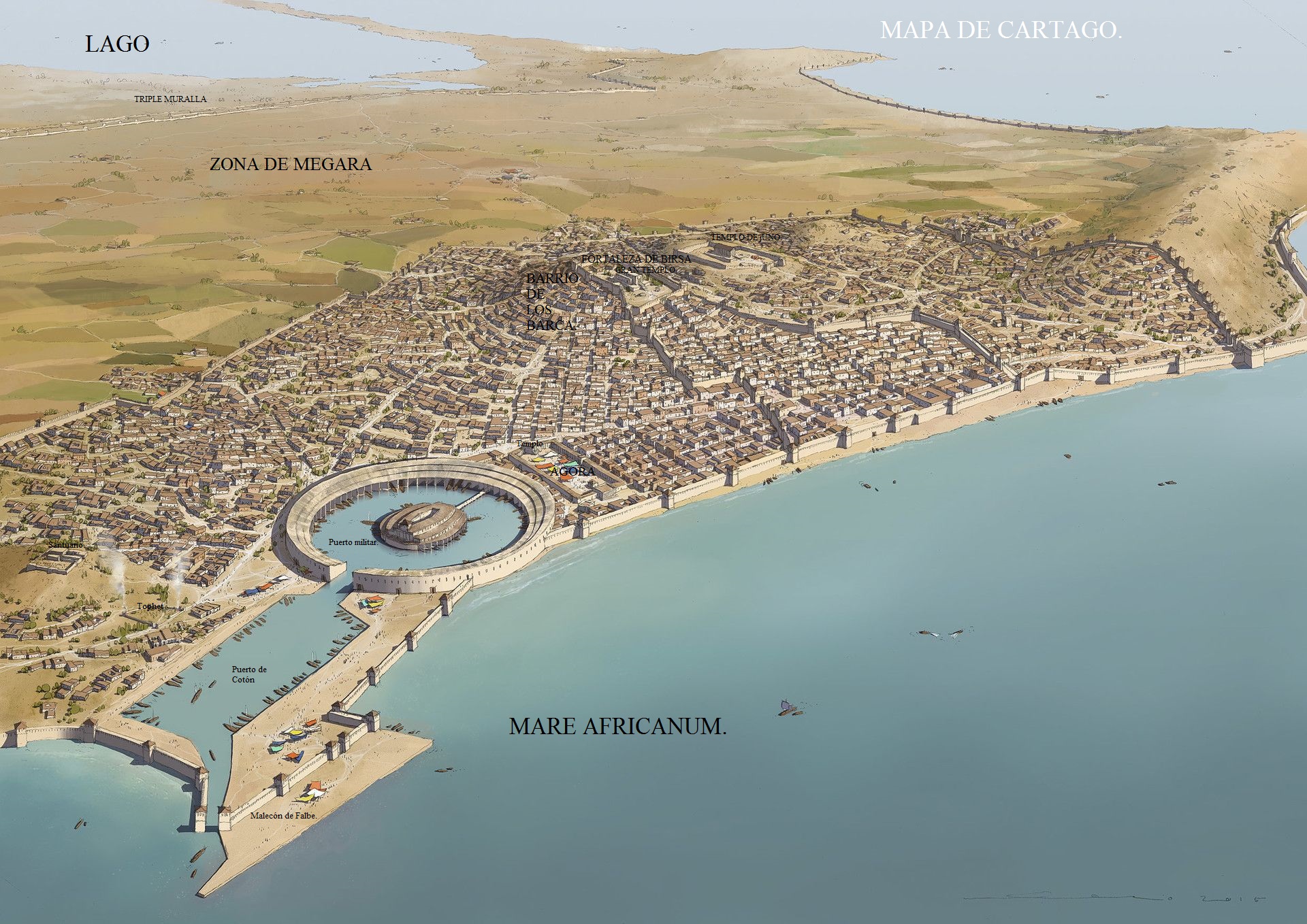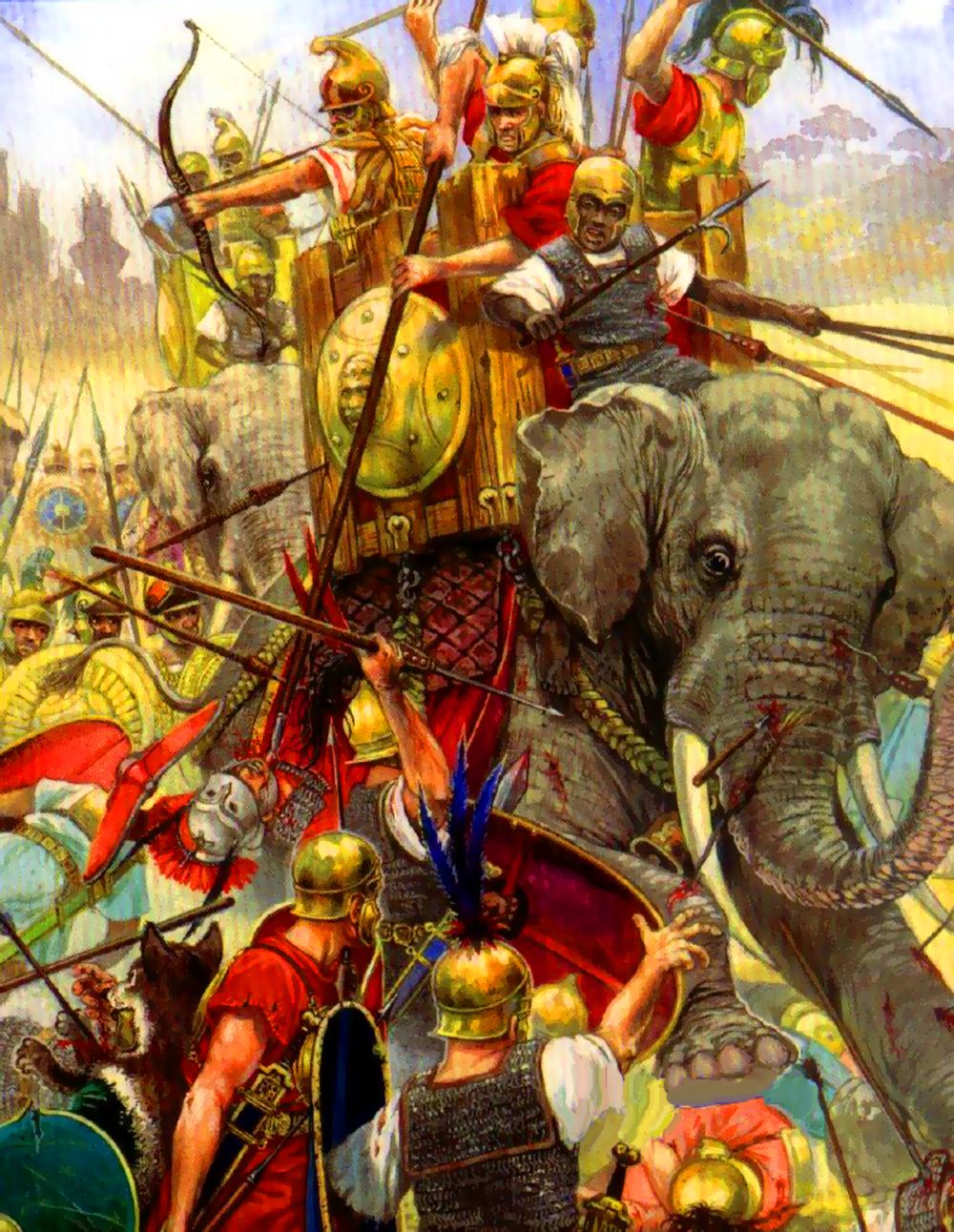The Punic Wars
When, in 272 B.C., the Greek colony of Taranto, in southern Italy, fell into the hands of the Romans, Rome already dominated the entire peninsula and had become one of the most powerful states around it. It was only a matter of time before his path crossed with that of the other great power of the western Mediterranean: Carthage.
The city of Carthage, on the north coast of present-day Tunisia, had been founded in the 9th century B.C. by Phoenician sailors, who built this huge port in the centre of the trade routes that crossed the Mediterranean. In addition to its strategic position for trade, Carthage was surrounded by fertile lands, and very soon, the Carthaginians (who also received the name of Punic), extended their domain to Sicily. There they made contact with the Romans, who were in full expansion, and the two powers began to be guarded with suspicion.

Sicily, rich in cereals, was populated by thriving Greek colonies, many of which were dominated by the Carthaginians. However, one of them, Messina, located in the strait between Italy and the island, decided to call the Romans to help them expel the Carthaginian garrison that controlled the city. When Messina's messengers arrived at the Senate there was a long deliberation. Everyone was aware that sending military aid to the city would trigger a terrible confrontation with Carthage, whose last consequences were unpredictable.
In the end, the Romans decided to send their soldiers. It was the year 264 B.C. and thus began the first of the Punic Wars, three terrible confrontations between Romans and Carthaginians that would decide the fate of the Mediterranean Sea.
________________________________________________________________________
The First Punic War
264 bc - 241 bc
Rome - which had only a small fleet - barely had experience in naval battles. So, at first, the Carthaginians easily destroyed the ships that the Romans sent, poorly directed by their inexperienced admirals.
But each defeat taught the Romans something new. In the end, they realized that their infantry was superior to the Carthaginian, and decided to take advantage of that advantage. To do this, they designed wooden walkways finished in hooks (corvus), with which the legionaries could cross to the enemy ships. The Carthaginians knew how to handle their triremes better, but their sailors were not prepared to fight melee, and ended up being defeated.
After twenty long years of war, in 241 B.C., the Romans became the sole owners of Sicily, which became the first Roman province.

________________________________________________________________________
Activity
In groups, draw a timeline with the main events of the First Punic War.
________________________________________________________________________
The Second Punic War
218 bc - 202 bc
During the years that followed the first confrontation, the Punics had extended their dominance through the Iberian Peninsula by exploiting the resources of this rich peninsula (precious metals, and soil fertility), led by Hamilcar Barca, to be able to pay to Rome the numerous war indemnities and to enjoy an area of expansion away from their rival, without danger of colliding with their interests. They had done so well, that Carthage was strong again.
Rome contemplated the recovery of the Punics with concern. In the year 226bc a Roman embassy met with the Barca (not directly with Carthage but with the military leaders in the Iberian Peninsula) forcing them to set a limit to their expansion in the Ebro river barrier.
Rome required Carthage to stay away from any scenario close to its interests. If the Punics extended too far to the North, in addition to affecting the Greek colonies dominated by Massilia (ally of Rome), they could connect with the Gaul tribes of Northern Italy, a traditional threat from Rome, which had recently been subdued. And Rome was not willing to take that risk.

South of the river Ebro, Sagunto was a town which did not obeyed to Carthaginians, but it entered into an alliance with Rome. Hannibal (Hamilcar´s son) besieged the town under the pretext that the Sagunto attacked one of the tribes, which were under Carthage authority. Sagunto resisted over the course of eight months. However, when Sagunto was occupied in 219 BC, the Romans sent a mission to Carthage with a demand to hand them over Hannibal. When Romans demand was rejected by Punic, this was a trigger for war.
This was the start of the Second Punic War and a 15-year invasion of Italy by Carthage's most celebrated general, Hannibal.
Leaving Spain in 218 BC, Carthaginian general Hannibal led a formidable army over Pyrenees and the Alps during the treacherous winter in order to invade Italy from the north.
Hannibal Invades Italy
Although losing many of his men crossing the Alps, Hannibal swooped down on Northern Italy with 26,000 soldiers that included: Spanish infantry, the superbly trained Numidian cavalry, and war elephants (most had perished before arriving in Italy). Hannibal believed he could augment his army with anti-Roman Gauls as well as city-states willing to trade allegiances.
Rome sent several armies against Hannibal. All efforts, however, resulted in Roman defeat. At both Trebia and Lake Trasimene, Hannibal displayed his genius, employing envelopment tactics that virtually obliterated the legions.
The battle of Cannae, fought in Southern Italy, represented the greatest Roman defeat in its history. The Senate had unwisely given joint command to two inexperienced consuls. Hannibal out-flanked the Romans who were caught in a pincer movement.
Scipio Africanus
In 210 BC an untried but energetic 25-year old Publius Cornelius Scipio, convinced the Roman Assembly to permit him to invade Spain and destroy the Carthaginians in their most prosperous province. Scipio had mastered Hannibal's battle tactics and would employ them against Hasdrubal, Hannibal's younger brother.
Scipio continued his conquest of the Iberian Peninsula, ultimately joining it to Rome.
End of the Second Punic War
For the most part, Rome's allies remained loyal. Minor defections, such as Capua, were quickly defeated. Additionally, Hannibal lacked siege equipment necessary to breach Rome's walls at a time when no legions stood between him and the city.
In the end, as Roman general Publius Cornelius Scipio took the war to the gates of Carthage after brilliantly winning Spain for Rome, Hannibal was forced to return and defend the city. Additionally, former Carthaginian allies joined Rome. In this manner, Scipio's army would face Hannibal at Zama in 202 BC with the asset of the Numidian Cavalry.
Hannibal lost the battle of Zama, in large part due to the change in alliance that saw the Numidians fighting for Rome. Carthage had lost much territory and was reduced to an insignificant city-state, ending over 500 years of Carthaginian dominance of the Western Mediterranean.
Military historian Lynn Montross suggests that "improved Roman generalship became a genuinely decisive factor eight years after Cannae..." Men like Scipio Africanus had learned well Hannibal's tactics and used them to achieve victory.
The Third and final Punic War would fully destroy the city years later.

______________________________________________________________________
The Third Punic War
149 bc - 146 bc
"The First and Second Punic Wars (264-241 bc and 218-201 bc) had effectively deprived Carthage of its political power. Nevertheless, its commercial enterprises expanded rapidly in the 2nd century bc, exciting the envy of Rome's growing mercantile community. When the Carthaginians in 150bc resisted Masinissa's aggressions by force of arms, thus formally breaking the treaty with Rome, a Roman army was dispatched to Africa. Although the Carthaginians consented to make reparation by giving 300 hostages and surrendering their arms, they were goaded into revolt by the further stipulation that they must emigrate to some inland site at least 10 miles (16 km) from the sea, making impossible the commerce by sea that drove the city's economy.
Carthage resisted the Roman siege for two years. In 147, however, the command was given to Scipio Aemilianus, the adopted grandson of the former conqueror of Carthage. Scipio made the blockade stringent by walling off the isthmus on which the town lay and by cutting off its sources of supplies from overseas. His main attack was delivered on the harbour side, where he effected an entrance in the face of a determined and ingenious resistance. House by house he captured the streets that led up to the citadel. Scipio ordered the city to be burned, then demolished.
Of a city population that may have exceeded a quarter of a million, only 50,000 remained at the final surrender. The survivors were sold into slavery, the city was razed, and the territory was made a Roman province under the name of Africa."
______________________________________________________________________
Activity
Make a mind map explaining the Punic Wars.


